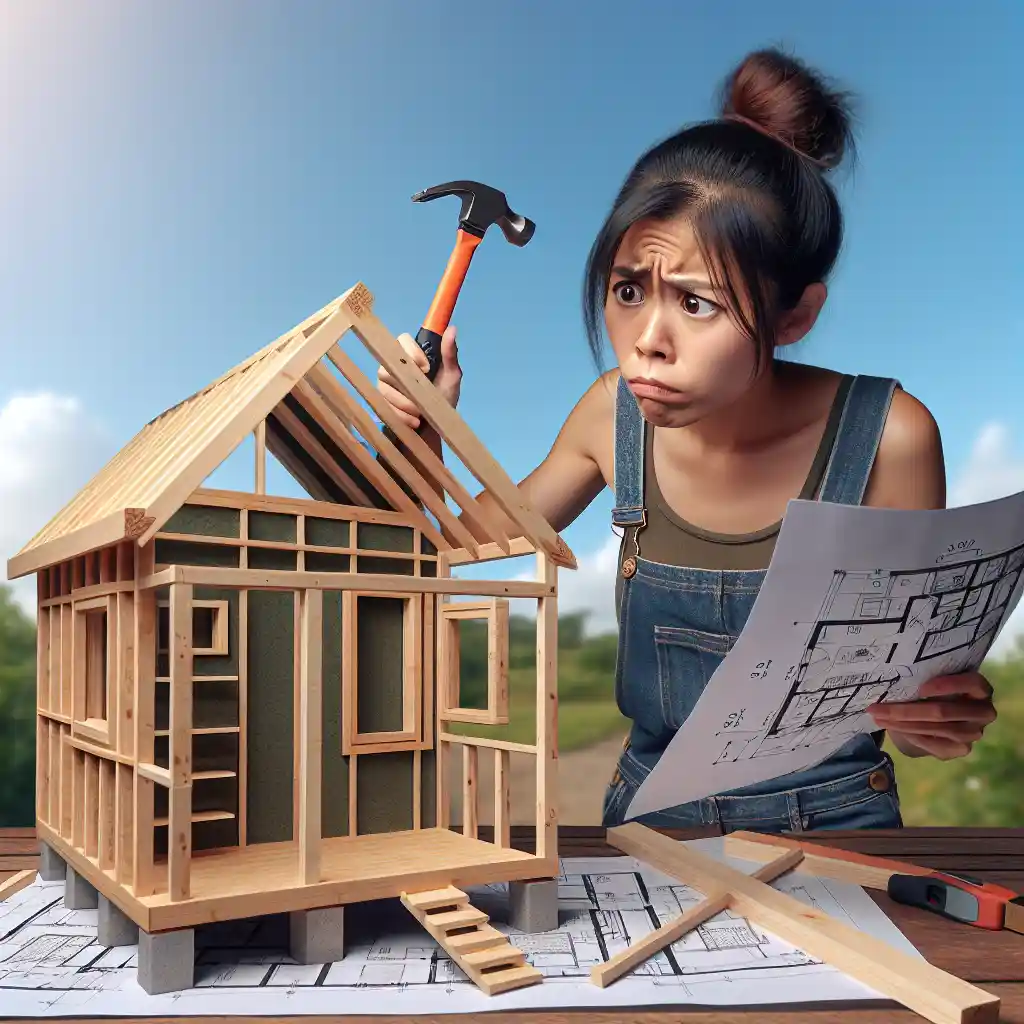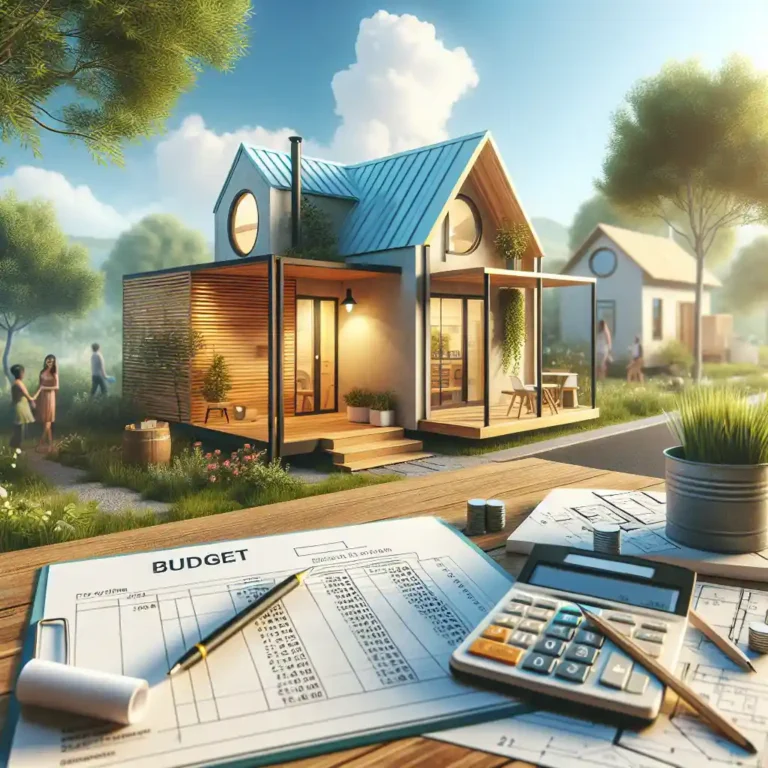The dream of a simpler life has many turning their eyes to the tiny house movement.
Financial considerations are crucial, as with any endeavor to build a home.
Let’s guide you through the financial labyrinth of creating your pint-sized abode, from rough estimates to intricate cost analyses.
Budgeting for Your Tiny House
Embarking on the journey to construct a tiny home requires meticulous budgeting. This typically involves considering various expenditures such as acquiring land or securing a spot for the house, obtaining necessary permits, purchasing construction materials, covering labor costs if you’re not going the DIY route, and ensuring your utilities are set up. Additionally, as you ponder the feasibility of tiny house living, you’ll need to keep in mind the finite square footage you’ll be working with, which directly impacts materials and furniture selection.
Researching average costs of similar tiny homes within your desired locale lays the groundwork for a comprehensive financial plan. Whether you’re aiming for a traditional house on a permanent foundation or a flexible house on wheels, you must tailor your budget to accommodate installation of essential services or the choice of sustainable options such as solar panels. Gathering this data ensures you’re not caught off guard by unexpected house costs during your project.
When crafting your financial strategy, the price range of materials is pivotal as they can account for a significant chunk, typically 30-50%, of your tiny home budget. A spectrum of prices exists, with materials alone ranging on average from $14,000 to $52,000, influenced by house size and the choice between standard components or custom homes luxuries like marble countertops. Every additional expense, from the upfront costs to more invisible fees like property taxes, influences the total investment in your tiny house movement endeavor.
Determining Your Budget
Tiny houses present a cost-effective alternative to larger traditional homes, with DIY constructions generally costing between $10,000 and $30,000. If you choose to engage a builder, anticipate your costs to double. A 100-square-foot house might hover around the average cost of $28,000, but depending on materials, labor, amenities, and house size, this can fluctuate from $16,000 to $40,000. To mitigate unforeseen costs, which are almost inevitable, adding an additional 15% to your budget as a contingency is wise.
Permit costs will also factor into your budget and can range from $900 to $2,500; fees are contingent on the complexity of your project, its location, and whether your tiny home is stationary or mobile. Additional expenses that can significantly impact your budget include long-term maintenance, utilities setup, and whether your home utilizes recycled materials, which may reduce costs. It’s also sensible to research local zoning laws, as they can influence where you can park or build your tiny house and potentially its overall design and cost.
Researching Financing Options
To finance your tiny home dream, you could start with personal savings or loans from friends or family. Personal loans from financial institutions or home equity loans could provide further options, especially if you currently own a property. Specialized tiny house loans have emerged catering to those aligned with the tiny house communities, offering tailored terms for smaller, less conventional house types.
It’s essential to recognize that traditional mortgages might not be available for tiny homes, mainly due to their diminutive size and lower cost compared to a traditional house. Financial considerations will likely lead you toward specialized lenders who acknowledge the rising popularity and practicality of tiny house living. Should your tiny refuge be a house on wheels, securing an RVIA certification might qualify you for an RV loan, while homes on permanent foundations can potentially access the manufactured or mobile home loan market.
In reviewing financing options, compare interest rates, repayment schedules, upfront costs, and eligibility criteria. A solid credit score strengthens your application and could lead to better finance terms, thus affecting the total cost of your tiny house project.
Considering DIY vs. Hiring Professionals
For potential tiny house owners, the decision between DIY and professional construction is paramount. Engaging with professional builders brings expertise and efficiency to your project, ensuring the structural integrity of your tiny abode. Additionally, professionals are equipped with the correct tools and are presumed knowledgeable about local building regulations, aspects that ensure the quick and lawful completion of your house.
However, these services come at a higher price, representing a proportionately larger segment of your budget. In contrast, a DIY approach might save on labor costs, but you need to evaluate whether you possess the required skills and knowledge, especially in specialized trades such as electrical or plumbing work.
Going the DIY route without the correct background may result in costs later down the line for corrections or professional assistance. Additionally, while a builder might offer a guarantee on their work, DIYers have to shoulder the full risk of potential costly mistakes.
Ultimately, whether you opt for a tiny house on wheels or a custom-built home on a fixed foundation, weighing the advantages of professional workmanship against the potential savings from a DIY approach is critical in achieving your tiny house living ambitions without compromising on safety or quality.

Factors that Affect the Cost of Building a Tiny House
Building a tiny house is not just an architectural project; it’s a lifestyle choice that reflects a commitment to minimalism and sustainable living. However, the cost of constructing one of these diminutive dwellings is influenced by various factors, from house size to the type of materials used, as well as whether professional labor is employed. A tiny house’s price tag can swing dramatically based on its location, the materials chosen, labor costs, and the degree of customization desired. The average cost hovers between $30,000 to $60,000, though more frugal budgets can see costs as low as $8,000, and more lavish builds may reach $150,000. It’s often more economical to build a tiny house rather than purchasing a pre-built one, but be aware of hidden costs, such as those for connecting to utilities, which can significantly raise the total expenditure.
Type of House – On Wheels, Trailers, Foundations, Shipping Containers, Bus Conversions
Unique among traditional homes, tiny houses come in varied forms including those on wheels, trailers, built atop permanent foundations, and converted from shipping containers or buses. These differences greatly impact the bottom line. On average, tiny houses on wheels run between $60,000 to $80,000, while acquiring a trailer for a tiny build ranges from $4,500 to $9,000. Bus conversions can set a homeowner back anywhere from $30,000 for a basic fit-out to more than $130,000 for an upscale conversion. Ranging widely in price, prefabricated tiny houses start at $4,000, jumping to $180,000, not including interior finishes. Shipping container conversions generally fall between $20,000 and $45,000, while stationary tiny houses on foundations average $51,000 to $53,000.
Size of the House
The size of the tiny house is a primary determinant of the cost. Defined by the American Tiny House Association and the International Residential Code as being under 500 square feet, these homes are a mere fraction of the size of larger homes. The average U.S. tiny house spans about 225 square feet, loft included, which is indicative of the movement’s emphasis on space efficiency. Houses ranging from 100 to 400 square feet are common, while crossing the 600-square-foot threshold generally means a home would no longer be considered “tiny.”
Brand of Materials
The brands of materials chosen for a tiny house can greatly influence the project’s total cost. Known brands such as Chattanooga and Volstrukt furnish tiny homes that can cost from $15,000 to $25,000, offering items like frames or kits suitable for self-assembly. On the more expensive side, Clayton Homes provides pricing from $100,000 to $200,000, targeting those who desire a ready-to-move-in solution. It is essential to select a brand that matches the expected service and budget requirements, considering not only the upfront cost but also the longevity and quality of the home.
Foundation Construction
The foundation is the bedrock of a tiny house, with the cost influenced by the choice of foundation type. Costs can range from a modest $5.00 to $8.00 per square foot, often translating to a total of $5,000 to $8,000 or even higher, depending on the complexity. A concrete slab foundation is the most economical, whereas a crawlspace or pier foundation might incur additional costs. Building on a foundation not only potentially appreciates the property value but also offers protection against certain environmental factors and can be beneficial for insurance purposes.
Labor and Permits
When constructing a tiny house, securing the correct permits is essential and factored into the project’s cost. The price of permits varies along a spectrum from $900 to $2,500, depending largely on location and scope. Additionally, the labor required for the build itself, if not undertaken as a DIY project, includes the expense of skilled contractors. Moreover, land survey costs for adequate site preparation can average between $200 to $1,200, further emphasizing the need to fully ascertain all possible costs before breaking ground.
Utility Access and Installation
For tiny homes that will not be off-grid, ensuring access to essential utilities is a key component of planning. Running utilities to a remote location can be a costly endeavor, potentially adding thousands to the budget. For homes that will integrate with existing municipal services, standard installation costs and fees need to be accounted for, ensuring that the home has reliable access to electricity, plumbing, and potentially sewer connections.
HVAC Installation
Equipping a tiny house with HVAC systems necessitates the installation of compact, efficient units. Mini-split systems are popular due to their dual function, providing heating and cooling while catering to the diminutive square footage of tiny houses. Installation costs for these systems usually range between $1,500 to $4,000. These smaller HVAC units not only ensure a comfortable living environment but also offer a balance of cost-effectiveness and adaptability.
Additional Costs – Land, Zoning Permits, Furnishings
Beyond the structure itself, other costs come into play. Acquiring land suitable for a foundation-based tiny house can cost between $5,000 and $18,000 per acre. Zoning permits, which can vary by municipality, usually range from $900 to $2,500. Outfitting a tiny home with furnishings and appliances adds additional expenses, ranging from $400 to $3,000 to the tally. Property taxes, while generally lower than traditional homes, can still add $200 to $1,000 annually to the owner’s outlay, and the expense of utilities hookup for a permanent site can run from $4,000 to $12,000. It’s imperative for potential tiny house owners to consider every facet of cost—both upfront and ongoing—to accurately budget their small-scale dream home.
Cost Breakdown for Different Types of Tiny Houses
Tiny houses come in various shapes, sizes, and forms, each with its unique price tag influenced by a variety of factors such as square footage, location, materials, and whether the tiny house is on wheels, a foundation, or converted from a structure like a bus or shipping container. Understanding these costs can help potential tiny house owners navigate their building or purchase decisions with greater confidence. Let’s dive into the cost breakdown for different types of tiny houses.
Cost Breakdown for Tiny Houses on Wheels
Tiny houses on wheels are a popular choice for those seeking mobility and flexibility. The average cost for constructing one of these homes is typically between $60,000 to $80,000. A significant upfront cost for this type of tiny house is the trailer, which serves as the house’s mobile foundation. You can expect to spend around $5,000 to $9,500 for a trailer suitable for your needs. For those opting for prefab models, fully assembled and finished homes on wheels can range from $25,000 to $80,000. It’s important to consider that location plays a role in the pricing with tiny houses on wheels, as some states have higher average costs due to demand and local regulations.
Cost Breakdown for Tiny Houses on Trailers
Building your tiny dream home on a trailer can cost you somewhere in the range of $4,500 to $11,000, which includes considerations for the trailer’s length, width, material, and design. Importantly, tiny houses on trailers are usually recognized as personal property and are exempt from real estate property taxes but may incur other forms of taxation. If you decide to anchor your tiny house to a piece of land, the average cost of land across the United States is about $16,182 per acre, although this significantly varies depending on the location. When considering a foundation, this cost can fall between $3,000 and $9,000, contributing to long-term stability and property value.
Cost Breakdown for Tiny Houses on Foundations
For those who prefer a stationary tiny house, one built on a foundation is a common route. The construction costs range from $53,000 to $57,000 on average. The foundation itself can cost approximately $5.50 to $8 per square foot, depending on the materials and complexity of the installation. When it comes to acquiring the property, a tiny house on a foundation can have associated land costs varying from $2,500 to $81,500 per lot, with an average hovering around $42,000. Lastly, a careful selection of materials is key, including aspects like scaled-down fixtures and appliances, which can range from roughly $14,050 to $54,800, shaping the final cost of the build.
Cost Breakdown for Shipping Container Conversions
Turning a shipping container into a habitable space is a budget-friendly and sustainable approach within the tiny house movement. Basic conversions might start at around $20,000, while more elaborate and larger builds can ascend to $100,000. The container itself acts as the frame of the house, and depending on how many are used, their dimensions, and the level of customization planned, costs will vary. A single converted shipping container home typically falls in the $20,000 to $45,000 bracket, making them an appealing option for some due to their affordability.
Cost Breakdown for Bus Conversions
Bus conversions, or “skoolies,” are an inventive form of tiny houses that range in cost. You could spend less than $30,000 for a basic build or more than $130,000 for a high-end one. The bus’s price, ranging from $4,000 to over $10,000, combines with the materials and labor necessary to complete the interior. On average, the cost is generally in the ballpark of $30,000 to $50,000. The total expenses can fluctuate based on the bus size, its mileage and condition, and also on the quality and range of amenities included in the conversion. Along with the initial build costs, potential owners should factor in the cost of utilities and other services that will be required to make the bus a comfortable, livable space.
In review, the cost of building a tiny house is as varied as the options available for customization and personalization. Whether choosing a tiny house on wheels, on a foundation, a converted container, or a bus, each type has distinct costs that should be carefully considered in the planning stages to ensure a financially feasible project.
| Type of Tiny House | Average Cost Range |
| Tiny House on Wheels | $60,000 – $80,000 |
| Tiny House on Trailers | $4,500 – $11,000 (just the trailer) |
| Tiny House on Permanent Foundation | $53,000 – $57,000 |
| Shipping Container Conversion | $20,000 – $100,000 |
| Bus Conversion | <$30,000 – >$130,000 |
Each cost is influenced by various factors including the house size, materials, amenities, and the zoning laws and property taxes of the location it resides. Additional expenses could involve things like a house trailer, a permanent foundation, solar panels, and whether new or recycled materials are used. Financing options, credit score, and participation in house communities can also play critical roles in the affordability and feasibility of the house project. For those drawn to tiny house living, it’s important to plan a budget that accounts for all potential costs—both upfront and additional—to ensure a smooth transition into this lifestyle.
Important Considerations
When you’re planning to build a tiny house, several factors will significantly influence both the process and the total cost. Building a tiny house on wheels provides the allure of mobility and a sense of freedom, with trailer costs on average ranging from $4,500 to $9,000—this depends on factors such as the house size and the trailer quality. If you’re considering a stationary tiny house, typical building costs average around $53,250, this can creep upwards when adding in the foundation, which costs approximately $6,835 on average.
Tiny house building costs can be as variable as those for traditional homes and depend greatly on factors including:
- The square footage
- The type of foundation (a house on wheels vs. a permanent foundation)
- Materials used (standard vs. recycled materials)
- Zoning laws and permits
- Location, especially in relation to utility connections
It’s also important to consider whether you will build the house yourself or enlist the services of a professional builder. Though hiring professionals can increase your upfront costs, benefits can include their expertise, efficiency, access to tools and resources, and warranties that can offer peace ofPatients mind.
Furthermore, when building a tiny house, especially on a permanent foundation, you may have to adhere to construction rules that mandate the use of licensed professionals for critical services like electrical, plumbing, and HVAC work. Even if you opt for a tiny house on wheels, there are still regulations to consider, such as the permissible size for mobility and the standards that must be met to ensure your vehicle is roadworthy.
Resale value of tiny houses
When it comes to the resale value of tiny houses, there’s a spectrum of considerations to keep in mind. Unlike traditional homes, tiny houses aren’t guaranteed to appreciate in value. High customization can often lead to depreciation due to the narrowed pool of interested buyers. Condition and features play pivotal roles, and those on wheels might experience wear and tear that can affect resale value.
Experts in the real estate market are optimistic that as the tiny house movement gains more traction, their resale values will also climb. However, the niche market aspect of tiny houses could mean longer wait times to find a willing buyer when compared to larger homes. Tiny homes on wheels may depreciate, akin to vehicles, while those built on a permanent foundation have the potential to appreciate, provided they are well maintained and feature quality materials.
Square footage considerations for a tiny house
Tiny homes are defined by their small size, generally under 500 square feet, and can range from being situated on mobile platforms to resting on permanent house foundations. The average size of a tiny house is about 300 square feet. For those who wish to go smaller, homes less than 100 square feet can cost as little as $10,000, assuming basic finishes and a DIY approach to construction.
Square footage is a dominant factor in cost; beyond 300 square feet, expect proportionally higher expenses, with the price tag for luxurious custom homes reaching between $70,000 to $150,000 for just 200 square feet. Cost considerations should also factor in the location which greatly influences expenses—an average suburb property is pricier than rural property, for instance. To estimate a tiny home’s cost, you can often scale down the cost of a similar-sized standard house by about 45 to 50 percent as a starting point before adjusting for specific tiny house considerations.
Appreciation and depreciation of tiny houses
The potential future value of tiny houses is a mix of conjecture and early market analysis, as the movement is still fairly young. The appreciation or depreciation hinges on several factors: the condition of the house, whether it is on a foundation or trailer, quality of materials at the onset, and upkeep maintenance. While there’s no widespread concrete data to predict tiny houses’ resale worth, they fall into a unique category that isn’t as straightforward as traditional homes or RVs.
Maintenance is an absolute game-changer for tiny houses that may help in curbing depreciation. An immaculately maintained tiny home that boasts high-quality materials and is situated on a permanent foundation, may have a better chance of appreciating over time. However, a tiny house on wheels or one with too many niche customizations might not fare as well. DeepCopyregnThe future of tiny house living and their value trajectory will remain under scrutiny, pending more insights and market trends to guide potential owners on the financial implications of their investment.
FAQs
Can I build a tiny house with no experience?
Yes, building a tiny house is possible even without previous experience in construction. Enthusiastic individuals can embark on their house project with dedication and thorough research. By utilizing various available resources such as online guides and instructional materials, one can navigate the process step by step. While the task may seem daunting, many have found that the cost savings and the personal touch they can put into their tiny home outweigh the challenges. It is, however, important to recognize the commitment required to learn new skills and the patience needed to see the project through to completion. Additionally, some find that seeking out workshops or assistance from those with construction experience can be especially helpful.
Are there any grants or subsidies available for building a tiny house?
Grants or subsidies specifically tailored for the construction of tiny houses may not be widely available, but that doesn’t mean there aren’t opportunities to offset some of the costs. Building a tiny house offers financial benefits over a traditional home due to the reduced square footage, which translates to lower land, material, and labor costs. While the exact cost per square foot will vary depending on a multitude of factors, the resulting savings can be substantial enough to increase a house owner’s savings significantly. Purchasing tiny-house kits can also be a more accessible and economical route. These kits can help reduce the total cost and may be compatible with various financing alternatives. Prospective builders should research local and state programs, which occasionally offer grants, low-interest loans, or other subsidies for housing projects that promote sustainability or meet specific community needs.
How long does it take to build a tiny house?
The construction timeline for a tiny house vastly depends on the route you take. For a custom-built or fully-finished prefab tiny house, the average time from start to move-in is about 2 to 4 months. However, if you opt for a self-build, you should expect to invest anywhere between 500 to 1,000 hours, translating to approximately 6 to 12 months—depending on your level of experience and the time you can commit each week. It’s worth noting that due to increased demand and current material shortages, some builders are reporting longer-than-average delivery times. Additionally, local zoning laws can affect how quickly you can complete your house living dream, as regulations and required permits for tiny homes can vary significantly across different cities and municipalities, potentially extending your timeline.
Can I build a tiny house with no experience?
Absolutely, you can build a tiny house with no prior construction experience. The burgeoning tiny house movement has empowered many individuals to take on such projects with determination and the proper guidance. While the thought of creating a home from scratch can seem daunting, there is an abundance of resources available. From detailed guides to comprehensive online resources, the support you’ll find makes the learning curve manageable.
Cost savings are a significant motivator for those embarking on a self-build tiny house project, not to mention the immense personal satisfaction that comes with completing your own living space. When approaching this endeavor, keep the following in mind:
- Dedication: You must commit to the project, as building a tiny house requires time, energy, and patience.
- Research: Utilize resources such as DIY books, online tutorials, and workshops.
- Guidance: Don’t hesitate to seek advice or assistance from the tiny house community or professionals when needed.
Building a tiny house without experience is more than a dream; it’s a viable option for those ready to learn and put in the work. With the right mindset, you can join the ranks of house owners who’ve turned their tiny house living aspirations into rea



